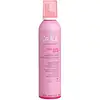What's inside
What's inside
 Key Ingredients
Key Ingredients

No key ingredients
 Benefits
Benefits

 Concerns
Concerns

 Ingredients Side-by-side
Ingredients Side-by-side

Water
Skin ConditioningMilk
Skin ConditioningGoat Milk
Skin ConditioningGlyceryl Stearate
EmollientPEG-100 Stearate
Parfum
MaskingCetearyl Alcohol
EmollientEthyl Macadamiate
Skin ConditioningC13-15 Alkane
SolventCitrus Limon Juice
Skin ConditioningPropylene Glycol
HumectantOlea Europaea Fruit Oil
MaskingBehentrimonium Chloride
PreservativeLitsea Cubeba Fruit Oil
MaskingDipteryx Odorata Seed Extract
MaskingEthyl Vanillate
PerfumingCetrimonium Chloride
AntimicrobialPhenoxyethanol
PreservativeBenzyl Alcohol
PerfumingAnise Alcohol
PerfumingBenzyl Benzoate
AntimicrobialBenzyl Cinnamate
PerfumingCinnamal
PerfumingCitral
PerfumingCoumarin
PerfumingGeraniol
PerfumingLimonene
PerfumingLinalool
PerfumingWater, Milk, Goat Milk, Glyceryl Stearate, PEG-100 Stearate, Parfum, Cetearyl Alcohol, Ethyl Macadamiate, C13-15 Alkane, Citrus Limon Juice, Propylene Glycol, Olea Europaea Fruit Oil, Behentrimonium Chloride, Litsea Cubeba Fruit Oil, Dipteryx Odorata Seed Extract, Ethyl Vanillate, Cetrimonium Chloride, Phenoxyethanol, Benzyl Alcohol, Anise Alcohol, Benzyl Benzoate, Benzyl Cinnamate, Cinnamal, Citral, Coumarin, Geraniol, Limonene, Linalool
Water
Skin ConditioningIsobutane
Propane
Acrylates Copolymer
Phenoxyethanol
PreservativePolyquaternium-11
Ceteareth-25
CleansingHydroxyethyl Cetyldimonium Phosphate
Aminomethyl Propanol
BufferingPPG-10 Methyl Glucose Ether
Skin ConditioningParfum
MaskingTocopheryl Acetate
AntioxidantPanthenol
Skin ConditioningPropylene Glycol
HumectantEthylhexylglycerin
Skin ConditioningAloe Barbadensis Leaf Juice
Skin ConditioningButane
Benzophenone-4
UV AbsorberEthane
Citric Acid
BufferingPotassium Sorbate
PreservativeSodium Benzoate
MaskingCitral
PerfumingLimonene
PerfumingWater, Isobutane, Propane, Acrylates Copolymer, Phenoxyethanol, Polyquaternium-11, Ceteareth-25, Hydroxyethyl Cetyldimonium Phosphate, Aminomethyl Propanol, PPG-10 Methyl Glucose Ether, Parfum, Tocopheryl Acetate, Panthenol, Propylene Glycol, Ethylhexylglycerin, Aloe Barbadensis Leaf Juice, Butane, Benzophenone-4, Ethane, Citric Acid, Potassium Sorbate, Sodium Benzoate, Citral, Limonene
 Reviews
Reviews

Ingredients Explained
These ingredients are found in both products.
Ingredients higher up in an ingredient list are typically present in a larger amount.
Citral is a fragrance and used to add a lemon-like scent to products. It is both naturally found in plants and created synthetically. In plants, it is commonly occurring in lemon myrtle, lemongrass, lemon tea-tree, lemon verbena, and other citruses.
The EU mandates Citral be listed separately as a fragrance. It is a known allergen and may cause contact dermatitis. Citral can also used as a masking ingredient.
The term 'fragrance' is not regulated in many countries. In many cases, it is up to the brand to define this term. For instance, many brands choose to label themselves as "fragrance-free" because they are not using synthetic fragrances. However, their products may still contain ingredients such as essential oils that are considered a fragrance.
The term 'citral' is a collective term for two geometric isomers: geranial/Citral A and neral/Citral B.
Learn more about CitralLimonene is a fragrance that adds scent and taste to a formulation.
It's found in the peel oil of citrus fruits and other plants such as lavender and eucalyptus. The scent of limonene is generally described as "sweet citrus".
Limonene acts as an antioxidant, meaning it helps neutralize free radicals.
When exposed to air, oxidized limonene may sensitize the skin. Because of this, limonene is often avoided by people with sensitive skin.
The term 'fragrance' is not regulated in many countries. In many cases, it is up to the brand to define this term. For instance, many brands choose to label themselves as "fragrance-free" because they are not using synthetic fragrances. However, their products may still contain ingredients such as essential oils that are considered a fragrance.
Learn more about LimoneneParfum is a catch-all term for an ingredient or more that is used to give a scent to products.
Also called "fragrance", this ingredient can be a blend of hundreds of chemicals or plant oils. This means every product with "fragrance" or "parfum" in the ingredients list is a different mixture.
For instance, Habanolide is a proprietary trade name for a specific aroma chemical. When used as a fragrance ingredient in cosmetics, most aroma chemicals fall under the broad labeling category of “FRAGRANCE” or “PARFUM” according to EU and US regulations.
The term 'parfum' or 'fragrance' is not regulated in many countries. In many cases, it is up to the brand to define this term.
For instance, many brands choose to label themselves as "fragrance-free" because they are not using synthetic fragrances. However, their products may still contain ingredients such as essential oils that are considered a fragrance by INCI standards.
One example is Calendula flower extract. Calendula is an essential oil that still imparts a scent or 'fragrance'.
Depending on the blend, the ingredients in the mixture can cause allergies and sensitivities on the skin. Some ingredients that are known EU allergens include linalool and citronellol.
Parfum can also be used to mask or cover an unpleasant scent.
The bottom line is: not all fragrances/parfum/ingredients are created equally. If you are worried about fragrances, we recommend taking a closer look at an ingredient. And of course, we always recommend speaking with a professional.
Learn more about ParfumPhenoxyethanol is a preservative that has germicide, antimicrobial, and aromatic properties. Studies show that phenoxyethanol can prevent microbial growth. By itself, it has a scent that is similar to that of a rose.
It's often used in formulations along with Caprylyl Glycol to preserve the shelf life of products.
Propylene Glycol is an odorless, colorless liquid. As a humectant, it helps skin retain moisture. It also aids in delivering active ingredients.
Another role of this ingredient is preventing a product from melting or freezing. Propylene glycol also adds antimicrobrial properties to a product, elongating product lifespan.
This ingredient is considered an organic alcohol and commonly added into both cosmetics and foods.
Those with sensitive skin or conditions may develop a rash when using this ingredient.
Learn more about Propylene GlycolWater. It's the most common cosmetic ingredient of all. You'll usually see it at the top of ingredient lists, meaning that it makes up the largest part of the product.
So why is it so popular? Water most often acts as a solvent - this means that it helps dissolve other ingredients into the formulation.
You'll also recognize water as that liquid we all need to stay alive. If you see this, drink a glass of water. Stay hydrated!
Learn more about Water